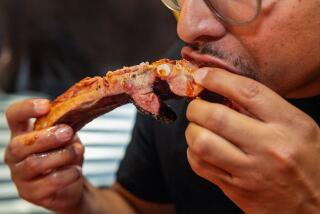Carolina Pork Plant Proud of Its ‘Skins’ : Presidential Snack Had Its Roots in Southern Poverty
- Share via
NAHUNTA, N. C. — Even in good times, it’s hard for Southerners to trash anything that comes from a hog. Hence the presidential snack, pork rinds.
“You don’t throw nothing away,” said Larry Pierce, manager of the Nahunta Pork Center here. “You use everything from a hog but the squeal.”
“It’s the finest food substance available on the planet,” said state Sen. Wendell Murphy, whose Duplin County hog farm is one of the largest producers of pork in the nation.
Hogs become ham, pork chops, bacon and sausage. The feet are pickled and the intestines are used as sausage casings. Hog tails are used for seasoning and the hides end up in fancy driving gloves, Hush Puppy shoes--and President Bush’s favorite munchy.
Pierce, whose plant produces pork rinds, thinks it’s great that Bush prefers them with Tabasco sauce, but if the President wants to sample Nahunta’s home-style skins, he’ll have to come to this crossroads 50 miles southeast of Raleigh to get them.
No Lack of Demand
“It will probably be good for the pork industry, but there’s not much way for it to help our business,” said Pierce, whose father founded the company 24 years ago. “We process 100 skins a week and can’t meet the demand from our customers as it is.”
The pork plant, which makes up most of Nahunta, was started as a slaughterhouse in 1955 and added retail sales in 1975. It does not distribute its products, but more than 3,000 people a week come by to buy fresh pork and cured hams. They also grab up 99-cent bags of Pierce’s salted and deep-fried pork skins.
“We process about 500 hogs a week,” Pierce said, “but we’re real particular about the skins we use. If they aren’t quite up to snuff, we won’t use them. That’s why we only turn about 100 skins a week into pork rinds.”
A special machine slices the skin off the meat. The skin pieces are cooked in vats for four hours to dry out the fat. Then the hardened, shriveled skins are deep fried.
The pieces pop and puff up as they are turned into crunchy slabs of rind in minutes.
‘Scientific’ Salting
“This is our scientific measuring process,” Pierce said as he dipped a handful of salt from a bucket and spread it over the fried rinds.
“Ones that come out like this, we throw away,” he said, plucking a dark, hard chunk from the sheets of golden fried skin. “And we’ve got two grades of rinds.
“The ones that come out really nice and thin are No. 1s,” he said. “Your thicker skins that come out a little tougher are No. 2s.”
A bag of No. 1s, which weighs a little more than 3 ounces, and a 12-ounce bag of No. 2 go for the same price, 99 cents.
“We actually sell more of the No. 2s,” Pierce said. “People seem to like to gnaw on them a little bit.”
A half-ounce serving of pork rinds provides little in the way of nutrition; potato chips and peanuts have more nutrients, but also more fat and cholesterol.
A U. S. Department of Agriculture analysis found that a 2-ounce package of rinds, with 315 calories, contains 32.5 grams of protein, 18.9 grams of fat, 58 milligrams of cholesterol and 1,054 milligrams of salt.
Year’s Sales Compared
The Snack Food Assn. said that in 1987, pork rind sales nationwide totaled $195 million, a figure dwarfed by potato chip sales, which came to $3.8 billion in the same year.
Dwayne Pilkington, a professor of food science at North Carolina State University, said the origin of pork rinds is lost in history.
“I don’t know when people started popping skins, or why,” Pilkington said. “I don’t know if it’s a takeoff from the old days of crackling, or what.”
Crackling, or cracklin’, is made by cooking hog skin that has had the lard pressed out of it. In some areas, the layer of fat was ground up with the skin to make the crisp treat.
“It could be that somebody had a piece of skin left over from cracklin’, put it on a stove and it popped--sort of an accidental discovery,” Pilkington said.
Same Old Rind
Pierce said he isn’t sure why the popularity of pork rinds has been limited mainly to the South.
Murphy, a Democrat who raises a million hogs a year, said: “Anybody that doesn’t like them has just never tasted them.” He said he was aware of the Republicans’ use of symbolism in the 1988 presidential campaign, but he did not believe Bush had used pork rinds to counter a less-than-macho image.
“I really think he ate them before the presidential campaign,” Murphy said, “but maybe nobody paid much attention to what he ate when he wasn’t the President. The office sure changes that.”
More to Read
Sign up for Essential California
The most important California stories and recommendations in your inbox every morning.
You may occasionally receive promotional content from the Los Angeles Times.













